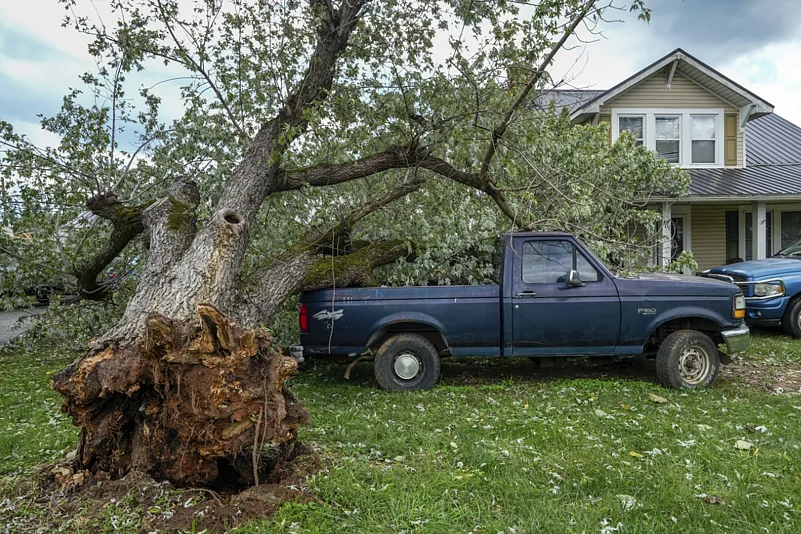Hurricane Helene has caused widespread damage across the Southeast United States, leaving nearly 100 people dead and isolating communities. Authorities are working to deliver water, food, and other essential supplies to areas that remain cut off due to flooding, landslides, and collapsed infrastructure.
Death Toll Nears 100 After Hurricane Helene Devastates Southeastern US, Aid Efforts On
Hurricane Helene has devastated the US Southeast, leaving nearly 100 people dead and communities cut off due to flooding and infrastructure damage.

The death toll, which currently stands at 91, is expected to rise as rescuers reach more remote locations, reported Associated Press.
North Carolina Hit Hard by the Storm
In North Carolina, Buncombe County reported 30 storm-related deaths. Asheville, a city located in the county, remains isolated, with supplies being airlifted to the region. Authorities have struggled to deliver basic resources, and residents have been calling for more support.
Buncombe County Manager Avril Pinder addressed these concerns on Sunday, assuring residents that food and water would arrive soon.
“We hear you. We need food and we need water,” Pinder said during a call with reporters. She added that county officials have been in contact with state authorities and other organizations to get support for the area.
Rescue and Recovery Efforts
North Carolina Governor Roy Cooper warned that the number of deaths will likely increase as rescuers reach areas that have been cut off by collapsed roads and flooding. He urged residents to avoid traveling to keep the roads clear for emergency vehicles. More than 50 search teams are working throughout the region to rescue stranded individuals.
In one rescue operation, teams saved 41 people north of Asheville. In another case, an infant was rescued after a team located the family using a social media post. North Carolina National Guard Adjutant General Todd Hunt said emergency responders have been using both 911 calls and social media to identify people in need of help.
Impact of Hurricane Helene
Hurricane Helene made landfall late Thursday in Florida’s Big Bend region as a Category 4 storm. It brought high winds and heavy rain that caused flooding, downed trees, and power outages as it moved across the Southeast. In Tennessee’s rural Unicoi County, patients and staff were airlifted from a hospital rooftop after floodwaters surrounded the building.
The storm has resulted in deaths across Florida, Georgia, South Carolina, and Virginia. South Carolina has reported 25 deaths, making Helene the deadliest storm in the state since Hurricane Hugo in 1989. The estimated property damage ranges from $15 billion to $26 billion.
Challenges in Providing Aid
As of Sunday night, more than 2 million homes and businesses remain without power. South Carolina has been hit hardest by the outages. Governor Henry McMaster asked residents to remain patient as crews work to restore power.
In Georgia, officials in Augusta and surrounding Richmond County announced that water service would be shut off for 24 to 48 hours due to storm debris blocking water pumps. Authorities have been distributing bottled water to residents in the affected areas.
North Carolina has also experienced widespread flooding, with some areas receiving more than 2 feet of rain. In the community of Spruce Pine, rising floodwaters left residents stranded. Jessica Drye Turner, a woman from Texas, had been pleading for help to rescue her family members stranded on a rooftop in Asheville. Her parents and nephew drowned when their roof collapsed.
Buncombe County has faced challenges in delivering aid due to blocked roads and mudslides. Mudslides along Interstate 40 and other roads have prevented the delivery of water supplies. The county’s water sources are on the other side of the Swannanoa River, leaving most of its 270,000 residents without access to clean drinking water.
Search and Rescue Efforts Continue
Law enforcement is working to ensure resources are distributed fairly as residents report shortages of food, water, and fuel. Authorities have received reports of arguments and threats of violence at locations that still have supplies. Emergency responders are continuing to search for stranded residents in remote areas.
FEMA Administrator Deanne Criswell toured southern Georgia on Sunday and plans to visit North Carolina on Monday. She said search and rescue operations are still active in western North Carolina and noted that many communities remain cut off due to damage to roads and bridges.
President Joe Biden described the impact of Hurricane Helene as significant and announced that he plans to visit the affected areas later this week. He emphasized that his visit will not disrupt rescue and recovery efforts. Biden approved a disaster declaration for North Carolina, which makes federal funding available to help affected individuals and communities.
FEMA has been coordinating with state and local officials to provide relief and support to the region. The federal government has pledged to assist with the recovery efforts as communities work to rebuild homes and infrastructure.
New Storm on the Horizon
While the Southeast is still recovering from Hurricane Helene, forecasters have identified a new tropical depression in the Atlantic Ocean. The National Hurricane Center reported that the depression could strengthen into a hurricane later this week.
The depression has sustained winds of 35 mph and is currently located west-southwest of the Cape Verde Islands. Forecasters expect it to become a hurricane by Wednesday.
- Previous Story
 US Elections 2024: Tim Walz, JD Vance To Go Head-To-Head In VP Debate | Key Issues To Watch Out For
US Elections 2024: Tim Walz, JD Vance To Go Head-To-Head In VP Debate | Key Issues To Watch Out For - Next Story
























